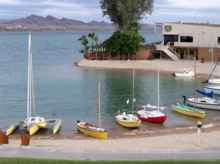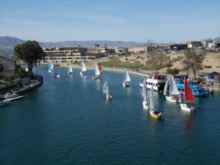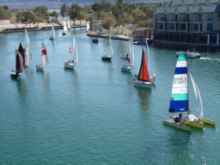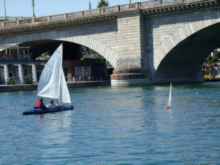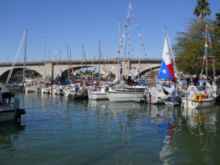
| sails |
| plans |
| epoxy |
| rope/line |
| hardware |
| canoe/Kayak |
| sailmaking |
| materials |
| models |
| media |
| tools |
| gear |
 |
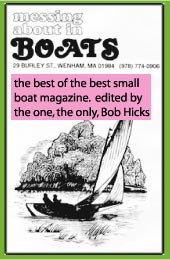 |
| join |
| home |
| indexes |
| classifieds |
| calendar |
| archives |
| about |
| links |
| Join Duckworks Get free newsletter Comment on articles CLICK HERE |
|
|
| Havasu Pocket Cruisers' Convention |
by Kim Apel and Dan Rogers - Los Angeles, California - USA |
Kim’s Part
Happily, there are an ever-expanding number and variety of gatherings for such like-minded boat people. Events such as the Kokopelli Cruise in the west and the Mid-Atlantic Small Craft Festival in the east are examples. Here’s one to add to the list: the HAVASU POCKET CRUISERS’ CONVENTION (HPCC), also known as “Sail Havasu”. This is an annual, week-long event, held each February on Lake Havasu, in the Mojave desert, on the Arizona-California border. https://www.sailhavasu.com
“HPCC” is the brainchild of Sean Mulligan, sailor and native son of Lake Havasu City, Arizona. Sailing on Lake Havasu used to be a lonely affair, before Sean hatched the idea to invite sailors to gather in February for this group event. Completing its fifth year in 2012, HPCC has grown from a small gathering to almost 400 sailors and 184 boats in 2012. This year crews came from 26 states, four Canadian provinces, and several countries overseas. Most trailered their boats, a few from thousands of miles away. Some flew in and found a spot crewing on others’ boats. Representatives of three sailing publications were present (Sailing, Good Old Boat, and Small Craft Advisor), so Dan and I nominated ourselves as correspondents. No small part of the appeal of the event is that it’s held in February, when the home waters of many participants may be frozen solid, or close to it. What sailor from northern climes wouldn’t want to get away and go sailing for a week during what is appropriately called, back home, “the dead of winter?” By comparison, Lake Havasu is paradise in February, the flip side of being sometimes the hottest place in the western hemisphere during summer. It’s not quite the Caribbean, but it’s pretty darn nice: you can drive there, you can bring your own boat, and you can hang out for what passes for cheap these days. Even for a southern California guy like me, accustomed to living near Disneyland, Lake Havasu has a “Land of Oz” quality about it. A big blue reservoir in the middle of the Mohave desert, the product of a giant 1930s government water project, would be strange enough. Add to that the personal vision of mid-20th century entrepreneur Robert P. McCulloch (think chainsaws and outboard motors) who was determined to build a city on its vacant shoreline, where summer temperatures exceed 120F. Then there’s Havasu’s best known landmark, the London Bridge. To establish an icon for his fledgling city, in 1968 McCulloch bought an historic, but obsolete stone-arch bridge from the city of London which was scheduled for demolition. It was disassembled, moved to the Arizona desert, and reassembled. Only after it was in place was a canal dug from the lake, under the bridge, in order that it might cross some water. A city of 53,000 has grown up around it. A waterfront hotel at the foot of the bridge, with King Arthur-themed décor, is the home base of the HPCC. Add to that, pink mountains on the horizon, consistent blue skies, knockout sunrises and sunsets . . . like I said: Oz. It must be acknowledged that many HPCC-goers may never have heard of a “messabout.” They are trailer-sailors, leaning mostly toward nice, shiny, production fiberglass boats in the 15 to 25 foot range, with familiar brand names, like West Wight Potter, Montgomery, Compac, MacGregor and Catalina. They mostly stay in nice hotels and tie up at night in nice marinas. They are cousins of the messabouters; perhaps not quite siblings. I prefer camp-cruising in my wooden boat, but I was willing to give HPCC a try for the spectacle of so many “cousins” gathered in one place. It’s impossible to summarize all the experiences worth mentioning, but I’ll share a few moments that hopefully reveal the “vibe” of HPCC : I attended with Dan Rogers, who had been at one of the early HPCCs four years before. Dan had since moved far away, but flew in for this event, and crewed on my boat. While checking in at HPCC headquarters, organizer Sean instantly recognized Dan, remembered his name and his boat’s name, and commented about how the two of them had “kicked butt” way back then. As an excuse to share the experience and spectacle of a lot of boats on the water at the same time and place, several casual “races” were held. This, despite the participants’ little interest or experience with serious racing, and the absurdity of handicapping such a diverse fleet. As a friend once explained about such events, “It’s not really a race; it’s a pageant.” Most participants needed an introduction or at least a refresher on even the most basic elements of a sail race, so we got a briefing, which boiled down the hundreds of racing rules to: 1) Avoid hitting anything with your boat; 2) starboard tack has right of way; 3) inside boat with overlap has right of way at the mark; 4) round all marks to port; 5) PFDs required; 6) Let courtesy and common sense prevail. Key West Race Week is a large, prestigious big-boat sailing regatta held each January that draws elite boats and crews from all over. A messabouter would avoid it like the Plague. HPCC is like Key West Race Week (KWRW) for non-racing trailer-sailors. HPCC’s “racing” is somewhere between an homage to and a satire of KWRW. Most messabouters would be glad to be there. Both events have websites, sponsors, vendor booths, social events, seminars, logo hats and shirts, and so on. Except almost everything about HPCC is small, especially the money. There’s no entry fee. Oh, and there are more boats at HPCC than at KWRW. Dan and I raced, but we knew we weren’t doing well to windward. We still wanted to know how we scored, and checked the results the next day, only to find that we had no score, because no one knew how to handicap my one-of-a-kind boat. If I wanted a score, I was asked to select a comparable one-design class, with a known Portsmouth number (standard handicapping index). We found one on the reference list. Sean plugged it in the computer, and we scored in the middle of the fleet, as expected. Such informality is not the way things are done at the yacht club. Nelson hauled his MacGregor 25 all the way from San Antonio, Texas. On the final leg of the race he flew a giant Texas flag instead of a mainsail. It hindered his racing, but he definitely got noticed. Later, back on the beach, he substituted a normal sized American flag until sundown. I was there at the time, in full messabout mode, that is, observing and talking about and trying out boats with whomever was around. Nelson came by, tapped me on the shoulder, and asked if I would help him take down the flag, and headed toward his boat without waiting for my reply. He had no way of knowing, but I’m a Boy Scout leader who knows that a guy needs help to properly strike the colors, so I followed. Nelson emerged from the MacGregor’s cabin with a trumpet. I took my position at the base of the mast. As he played taps, I lowered the flag slowly, like we learn in Scouting. A dozen or so people scattered around the cove stopped what they were doing and gave proper attention. John told me he does that to honor his deceased father who flew with the Flying Tigers in WWII in Asia. Howard Rice is a highly accomplished small boat sailor, including such things as rounding Cape Horn in a canoe. He attended HPCC, travelling from his home in Micronesia, in the Pacific, to be a seminar presenter. Everyone, including Howard, expected him to talk about his sailing exploits. But when the time came, Howard asked the indulgence of the audience to speak about his other passion, which is his work in Micronesia, planning for environmentally sustainable development in that poor nation. It was a risky move for an audience on vacation, but Howard received lots of positive feedback. While the overwhelming majority of HPCC boats are production pocket cruisers, tied neatly in their marina slips, there was enough diversity at the margins to make things interesting to a messabouter like me. One guy converted his Compac 16 to a gaff cutter rig, with bow sprit. Another converted an old West Wight Potter into a motor-sailer. There was a group of trimarans. Mike Monies, Texas 200 and Everglades Challenge veteran, brought his home-built Welsford-design “Scamp.” There were a smattering of San Francisco Pelicans, my 1955 Joe Dobler sloop, a Goat Island Skiff, a Bolger Nymph (tender to a Peep Hen), and a Klepper folding tandem kayak with a sail rig. There are beach-berth alternatives to the marinas. If you’re a hardy camper, you can sleep aboard, instead of hotel accommodations. There’s a pre-opening overnight event for camp-cruisers. Dates for HPCC 2013 have already been set. Many of those at HPCC 2012 have already booked their return trip. It’s a year away, but Dan and I intend to join them.
GUZZINTASDan’s PartWell, you see; it’s like this. I was absent the day they taught math in school. Mustabin. At least, on the day they taught the part about sumpthin’ and sumpthin’ else EQUALS sumpthin’ else. That part. It’s the thing, as I learned later on in life, that makes up the guzzintas. But, certainly, you—my better educated brothers and sisters—know what the guzzintas are. You do, don’t ya? OK, it goes like this, “two guzzinta four, twice…” Guzzintas. When it comes to money and time, there’s a slightly different equation. That one is called the LOTTA GUZZINTA. And, I just came back from a short trip that required one of those calculations. Let’s see now. If you take five commercial airliners and their aggregate TEN take offs and landings and layovers, add about 10 hours of driving—some of that in the dark and freezing rain, three nights in a motel, add in restaurant meals in several towns along the way, a couple-three hours of rigging, un-rigging, launching, loading, and wading around in 50 degree water—some of that in the pre-dawn darkness. Multiply by the coefficient of unbridled enthusiasm. Subtract for the variable constant factor of jet lag and disturbed sleep schedules. And, this all equals about 3 hours sailing time. Another one of those LOTTA GUZZINTA equations, I’d say. It probably wasn’t so much the day that I missed out on a mathematical education that led me to this calculus, so much as the day that I missed Common Sense Class. Now, that would have been a good one to show up for. What this is all about. My friend and fellow SCUZBUM, Kim, and I started “planning” to attend the annual Lake Havasu Pocket Cruiser Convention way back last fall. I had gone to this event a few years ago when it was in its infancy. That year, we pretty much did an overnight sail and held a group dinner. A nice event, but nothing like what it has grown to become. Kim went a bit later on. But, between us, we figured “a couple days there will be about right.” And, like I said, last fall when this conversation began, most anything seemed “reasonable.” Well, that would be flat out wrong. Wrong with a capital “R”! Yep, you could say that we simply blew it. This premier event in the small boat sailing world has simply become a “happening” that should consume the better part of a week, or more, PLUS travel time. Some folks are arriving—NOW—weeks in advance. And, they’re coming from all over the place. I mean, from ALL OVER THE PLACE. And, the organizer, Bosun Mulligan has simply gone all out in establishing a venue chock full of speakers, presentations, group meals, commercial venders, and SAILING EVENTS. Well, Bosun allows his humans, Sean and his wife, Jo, to do some of the microphone work from time to time. But, that dog is most certainly the brains behind the outfit. He told me so. And, the measly two days on scene that Kim and I were quite certain would “be enough for us,” only scratched the surface of the delightful stuff we could still be doing down in Arizona. At Lake Havasu. But, now, I’m already back here in the snowy and cold NW. It’s supposed to snow about half a foot more over the next day or so, for that matter. I could be having a ball down in Arizona with my new bud, Bosun the dog. Heck, my own dog is named Bosun, as well. And, he insists that I should have taken him along. Too. And we should’a stayed for the whole thing. And taken Lady Bug. And, sailed with the fleet all over that snow-free lake. And, even won some races. Yep, we shoulda’ planned this one a lot better. We just didn’t count up all the guzzintas.
|
